Beneath a canopy of oaks she paused and sniffed. She knew this place well. Her mother had brought her here. She snorted and twitched her nose as she looked at the strange but familiar vines that blocked her path. As always, they smelled of caves and blood, and a bit like the tasty dirts her mother had taught her to dig up and lick to stay strong. As a cub she had painfully learned that the vines were too tough to chew, with thorns that could pierce a tongue and cheek with ease. Her head shuddered with the memory. She continued along the twisted, barbed vines, and soon reached a small tree that had fallen across them. She deftly climbed over it. A short walk brought her out from under the oaks and onto a well-used trail. As was her way, she stopped and sniffed again.
New scents triggered a cascade of memories and associations. She could smell the fresh buds that would become leaves and acorns and berries (oh, yum!). The brush the deer loved was also surging with burgeoning blossoms. And she smelled the succulent shoots of the grasses and flowers that were pushing their way towards the Sun. And musty mushrooms. And the sharp odors of fresh termite tunnels and ant hills.
She ambled down the trail, her head swaying from side-to-side, her nose to the ground. She paused here and there to lick up ants and nibble shoots. A gray pile of droppings stopped her. She sniffed it. It was days old, and smelled of deer hair and bones. Deeper scents revealed more details about the leaver. She knew the cat. They had stared each other down several times over the years. He hunted deer here, and she had no taste for them. But she was no fawn either! Her senses were sharp, her neck thick, and if need be, her claws fast and teeth fierce. No, her mother had shown her that no ambush cat was her match. Her kind only changed trails for the uprights. They were too unpredictable.
She could smell the scents of uprights on the trail. Nothing recent though. Perhaps yesterday morn. 2 of them. They lived in these woods too, and she was approaching a den now. A creek trickled to her right. She stopped to eat grass in an open field. Her nose twitched and she looked up. A horn-headed owl sat above her on a gnarled, mossy oak branch, its wide-eyed gaze swiveling to watch her every move. She sniffed and grazed her way across the clearing, and then headed down the hill towards her favorite rock. It was big and flat, and in a creek on the edge of some falls and a pond. As she neared, two small gray foxes bounded by - more out of play than fear. She woofed at the little ones and set their scent in her mind. They were friends. They darted over the rocks and under the fragrant cedars, one on the tail of the other.
She stepped onto the big flat rock and drew air deeply. Her neck stretched up the creek, and then around and down towards the big pond. There were uprights in the big stone den above the creek, but none outside. Their scent was faint - they weren't active. She also smelled deer on the short grass by the pond. 5 of them. All females. She smelled fresh water of course. And frogs. Lots of frogs. No fish or crayfish though. Maybe a turtle. And various birds in the canopy starting to stir. No eggs yet. She sampled juicy plants along the bank. A "click" caught her ear and she went to investigate. It might be grubs under the bark of that pine tree. Or cicadas. But no, it came from an odd-looking thing clinging to the trunk. It wasn't food. It smelled strongly of uprights, and tasted wrong. It "clicked" again as she licked it. She woofed and moved up the shore. She was hungry, and there was lots of food around here, where the oaks and pines and manzanita met, and the snow rarely touched her belly.
======
About a year ago I bought a Moultrie heat-sensing digital trail camera to see what prowled around our family lodge. Seemed to be ideal for trapping - it's in the woods at 3,000 feet, the Forest Service land that borders Yosemite is practically spittin' distance, and a seasonal creek runs down from those wild lands and through our pond. Animals follow water. In the depth of winter I started getting my first pics. Deer, of course. A coyote - better. A mountain lion and a bobcat! Wow! We were hooked. What else was out there? What have we missed?
So, we decided to get a little systematic about documenting the flora and fauna around the lodge. Little did we know that we hadn't seen a fraction of the beautiful life the place had to show off.
The lodge is in what biologists call "the lower montane forest biotic zone of the Sierra Nevada." It's a high-density, high-diversity zone where the mountain and foothill plant and animal communities collide. A milder zone that sees hot summers, but also winters with light snow and some reasonable rain. A crossover zone of pine belts and oak woodlands and chaparral scrub. A cornucopia zone thick with nutritious leaves and berries and acorns and seeds and tubers, and a whole bunch of beasties happy to eat them, and each other.

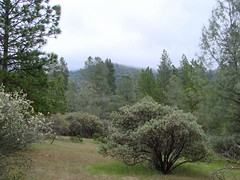
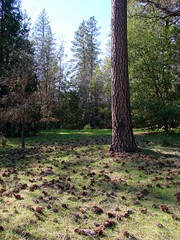
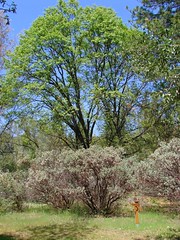
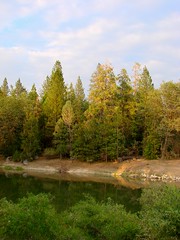
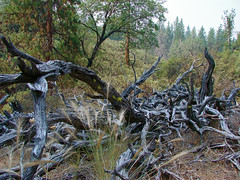
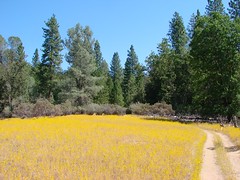
Mammals
On the mammal front, we've seen and photographed 20 species, including black bear, cougar, bobcat, coyotes, gray foxes, mule deer, raccoons, skunks, jackrabbits, gray squirrels, woodrats (many middens), voles, moles & bats. There were 6 new fawns this year. The puma got 3 so far.
Birds
Birds are tough to ID, let alone photo. We're up to 46 species, 6 of which are woodpeckers. Large groups of wild turkeys wander through, as do quail. A great horned owl pair had a youngin', and we watched it stare at us wide-eyed as it learned to fly ("branching," it's called). Red-shouldered hawks also raised a juvenile - we saw him eat a bullfrog on the dock and get in a tiff with the owl (with steller's jays cheering on). Nests found: robins, jays, phoebes, tanagers, towhees, bushtits, titmice, and woodpeckers. A pair of Canada geese brought their goslings to swim the pond. Too cute. Wish we could plug their backsides. Wood ducks visited too, floating serenely like perfectly-painted decoys.
Herps
In the world of critters that hop and slither, frogs and toads ruled the day. The lack of fish in the reworked pond allowed them to explode like a plague. The water was thick with tadpoles, and then the grass was thick with little hoppers - both pacific tree frogs and western toads. A turtle visited briefly, but before there was food. Bullfrogs transformed and took over the shoreline. They sat like evenly-spaced sentinels, ready to "erp" and leap at the slightest sign of insecurity. We even had one with a strange melanistic expression that caused black eyes and dark skin (like a black leopard). Blue-bellied fence lizards were common. Push-up, push-up. The only snake sighting was brief - a garter by the creek.
Trees, shrubs & wildflowers
As for flora... 5 species of oak, 4 conifers, 2 manzanitas, 3 ceanothus, buckeye, redbud, flannel bush, dogwood, gooseberry, coffeeberry, elderberry, blackberry, yerba santa, mountain misery, buttercups, shooting stars, fivespots, baby blues, 6 lupines, 3 monkeyflowers, 3 clarkias, 3 milkweeds, 3 mariposa lilies, 3 brodiaeas, 2 sunflowers, soap plant, madia, tarweed... In total, about 30 species of trees and shrubs, and over 100 species of wildflowers. And, all in a relatively dry season - the rain stopped in late March. Can't wait to see the flowers, when we get April-May showers.
Fungi, lichens, mosses & molds
Don't even get me started. Oops, too late. Just got my first books, so expect more on these soon.
Butterflies, dragonflies & other crawlies
Bugs, bugs, bugs... we saw lady beetles and cicadas bloom, and monarchs and tarantula hawks go after milkweed with zeal. We ID'd 12 species of butterflies and 10 of dragonflies, and had encounters with june, prionus and rain beetles.
What haven't we seen???
With fauna, we've seen almost all but the most rare. Haven't seen a ringtail yet, but the neighbors have. No weasels around. Dunno if there's been any. No chipmunks either, but they're higher elevation critters. A porcupine once, almost 10 years ago. No spotted skunks yet. Or grouse. Would love to see a pileated woodpecker. And cedar waxwings.
Seems to be almost no snakes around, which sucks cause I love 'em (and we could use the gopher eaters). Might be the turkeys are too tough on them. My dream would be to see a mountain king or rubber boa. It'd be great if the pond had some of the native red-legged and yellow-legged frogs, but the bullfrogs eat and out-compete them. Having native crayfish would be cool, so we're trying to find some to introduce.
Flora is much more hit and miss of course. I can't seem to find a jeffrey pine. Dozens of towering ponderosas, but no jeffreys. I'm starting to think that jeffrey pines are like snipes. Vanilla-scented bark and slightly-less-pointy cones huh? Biologists probably have a special collection sack they give newbies. "Just keep scratching bark, you'll find one..."
Wish we had more redbud. It's stunning. I'm going to try and grow some seedlings in pots for future transplanting. We do have lots of flannel bush though, which is great. No native hazelnut or blueberry, but I doubt the animals would ever let us enjoy the fruit!
That's year 1 (ish) of paying attention. Can't wait to see what this season holds.






























==========
Resources:
- Wikipedia - Ecology of the Sierra Nevada
- John Muir Laws - The Laws Field Guide to the Sierra Nevada

Wow. AMAZING diversity of life! Seems that's about the same type of bioregion we're in....we get many of the same plants & animals. (But lots of snakes, rubber boas, even! They love the garden....)
ReplyDeleteI love vanilla scented bark! :)
Your photos are fantastic. So great to see all the spectacular species our fair state has to offer. Much better than a biology class...keep 'em coming!
So nice of you to read my way-too-long post! Can't believe you get rubber boas - I'm so jealous. I've been a herp freak all my life and have never seen one. Maybe this year!
ReplyDelete